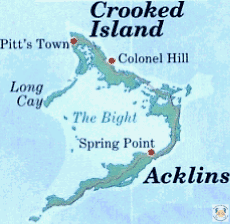Caribbean Tales - The Bahamas - Acklins/Crooked Island

Acklins/Crooked Island
These two islands are part of a group of four islands covering 100 miles,
240 miles southeast of Nassau. Fortune Island (Now known as Long Cay) flanks
Crooked Island and Castle island, Aklins Island. Columbus is alleged to have
come to the area searching for a place the aborigine Lucayans called Samoete,
where gold was rumoured to be available in large quantities, but the only
"treasure" he found was sensory, the jasmine-like fragrance in the air of
the cascarilla plants. Cascarilla bark was used to flavor Campari liquor as
well as the native Cascarilla Liqueur. Columbus also reputedly sailed down
the leeward side of the islands through the narrow Crooked Island Passage,
which has ever since served as an important route for steam ships travelling
from Europe to Central and South America. This seaway, referred to locally
as 'the going through,' also earned these islands the notorious reputation
as convenient bases for buccaneers and pirates, who attacked ships in these
shallow waters.
Acklins at 120 sq. miles is rocky and steep, long, narrow and hilly
and has numerous caves and bays along its western shores.
All along its coastline are numerous hidden coves with extensive, beautiful
beaches and a number of tiny, colorful, villages .Acklins Island has many
interestingly named hamlets, Rocky Point, Binnacle Hill, Salina Point, Delectable
Bay, Golden Grove, Goodwill, Hard Hill, Snug Corner, and Lovely Bay.
Crooked Island's 92 sq. miles is mainly comprised of tidal flats and deep
creeks, it opens onto the Windward Passage, the dividing point between the
Caribbean Sea and The Bahamas. Crooked Island's deliciously sweet scent of
native herbs and flowers inspired Columbus to call it "one of the fragrant
islands." He christened the island "Isabella" after his queen and it was called
"Samoete" by the Arawaks, but somehow, the more functionally descriptive Crooked
Island is the name it is known by today. An abundance of bird life thrives
on the cliffs and reefs around the islands and magnificent limestone caves
hide secrets from the past. Colonel Hill, on the northeastern end, is the
main town of Crooked Island; other towns include Cripple Hill, True Blue,
French Wells and Gun Point. Albert Town is the
only village on Fortune Island, in more prosperous times it served as a transfer
point for cargoes on ships sailing between Europe and the Americas.
The first Bahamian post office, served by the still-existing network of mail
boats, was located in Pittstown, once a thriving commercial centre. Guarding
the north end of this island is the Marine Farms Fortress, an abandoned British
fortification that saw action in the War of 1812. It looks out over Crooked
Island Passage, with six four-tonne cannons.
Fortune Island, is located on the southwestern side of Crooked Island. Albert
Town, its main settlement, is now sparsely populated though it was once a
prosperous little town. It was engaged in the sponge and salt industries and
also served as a port from which stevedores were engaged to serve on the German,
American and Dutch boats which then travelled to South America and the Caribbean.
Both islands, Acklins and Crooked, are enclosed in a shallow lagoon known
as the Bight of Acklins. The Bight of Acklins is a safe cruising ground
for shallow-draft vessels, with more than 1000 square
miles of shallow water. Extensive inland and marine cave systems are the subjects
of frequent explorers from overseas. The Ocean Den in the Bight of Acklins,
more than a mile long, is one of the most impressive marine caves in The Bahamas.
The islands existed in virtual obscurity until 1783, when American Loyalists
began to settle here. These former plantation owners brought slaves and money
to start a short-lived cotton industry which, by the beginning of the 19th
Century, had more than 40 plantations employing 1200 slaves, but as the Blight
in the 1820s destroyed most of the plantations, the islands soon became uneconomical.
Crooked and Acklins' strategic location made them a major port-of-call for
Atlantic steamship traffic. The area also prospered as a centre for growing
sea island cotton. Hope Great House is a 17th century colonial mansion at
Landrail Point. Bird Rock Lighthouse at Landrail Point.